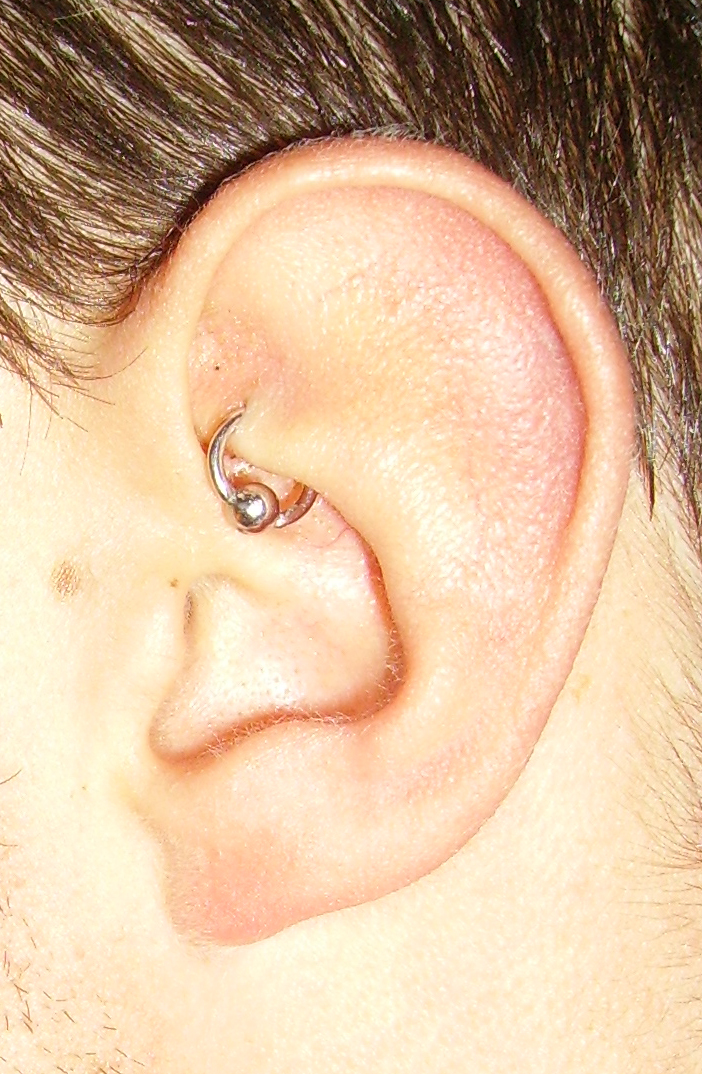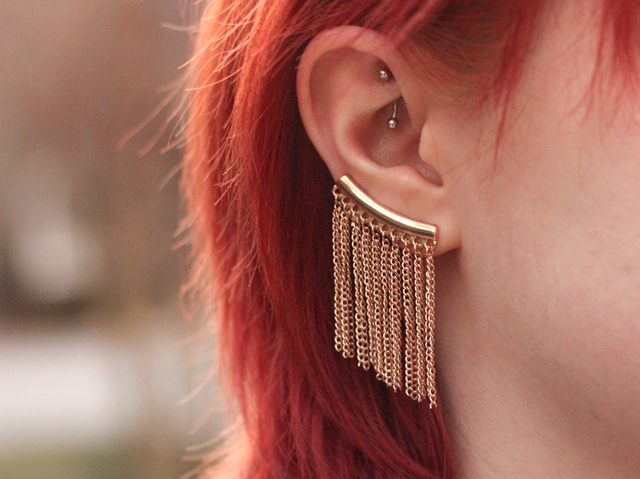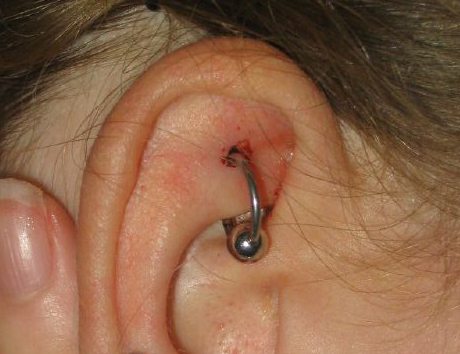Having a rook piercing is awesome because of the fact that not many people take notice of this part of your ear until you put a rook piercing jewelry that will definitely catch everyone’s interest. However, because each person’s ear anatomy is different from the others, some may not have a prominent rook to make this type of piercing stand out.
WHAT TO EXPECT
Before getting a piercing it generally is a good idea to be mentally and physically prepared. It’s always advised to go into the piercing parlor before your appointment. Here, you will be able to ask any questions that you have regarding the piercing.
On the day of piercing try and ensure that you have gotten a good night sleep so that your body is well rested. This will make the process a lot easier and you will be able to handle the actual procedure much easier.
You can expect a little discomfort and what many describe as a slight stinging sensation during the piercing. Overall, the entire experience is over before you know it and it really isn’t as bad as it sounds. If you feeling a bit worried, then take a friend along for some extra support.

PENTAX Image
HOW ROOK PIERCING IS DONE?
When arriving at the piercing parlor the individual will briefly walk you through the procedure. This will be followed by him/ her wiping the rook area so that it’s clean. Next, the area in which the ear will be pierced will be marked and finally, the piercing takes place. After the rook has been pierced the chosen jewelry is inserted.
The rook is located in the upper ear in the anti-helix above the tragus. This is the ridge area of the ear between the outer and inner conches.
The piercing is located in the inner fold of the cartilage just parallel to the helix. To simplify, it is two steps from your tragus and in between is the daith.
WHAT DOES ROOK PIERCING JEWELRY LOOK LIKE?
Almost all styles of piercing jewelry will look good on your rook. The most popular piercing jewelry used on the rook area is one of the following; ball closure rings (BCR), circular barbells (CBBs) mini curved barbells and, captive bead rings.
Here is a quick breakdown of the different types of jewelry that can be used:
- Ball closure rings- This piercing of jewelry is one of the most popular types because of how it is designed. The call closure ring has a captive ball that allows it to easily close. A great thing about the BCR is that it’s extremely secure and isn’t too tight on a rook area.
- Circular barbell- These are very versatile for any sort of piercing. Circular barbells don’t go all the way around, they can be determined as a ¾ circle and have screws on the ends.
- Mini curved barbell- A curved barbell is quite self-explanatory. The barbell on this jewelry is curved and it’s rather small in size. If you’re looking for an understated piercing, then choose a mini curved barbell as your choice of jewelry.
- Captive bead ring- This piece of jewelry looks very intimidating because it looks like it’s almost impossible to put on and remove. However, it’s actually quite easy once you figure it out. This hoop like piece of jewelry has a bead at the end of it which threads through the metal.
WHAT JEWELRY SHOULD YOU CHOOSE
For more depth and to acquire an even more stylish look you can customize the piercing with some clip-in attachments or threaded jewelry.
Curved barbells and captive bead rings are the most preferred for rook piercings because they allow enough room for healing. Smaller jewelry with pretty designs looks great on the rook. At a later stage, you can choose something more charming and stunning after the piercing has completely healed.
Needless to say, the most exciting part about getting a piercing is choosing the jewelry. Your piercing expert will advise you on what jewelry you can get based on the size of the hole. Only change jewelry once you’re entirely sure that the piercing is fully healed.

HOW MUCH DOES A ROOK PIERCING COST?
When choosing rook jewelry, the cost will largely depend on what material and design you like. Professional piercers will recommend a PTFE rook jewelry for a fast healing process. PTFE stands for Polytetrafluoroethylene. Popularly known as Teflon, has hypoallergenic properties which eliminate any risk of infection and rejection.
The actual cost of the piercing can vary from anywhere around $40- $60, depending on the piercing salon.
WHAT ARE THE VARIATIONS OF ROOK PIERCING?
If you have had other ear piercings before, you may want to be a bit daring and adventurous by having more than just one piercing.
Although the procedure is the most painful, double rook piercing will look stunning. Here, the inner cartilage ridge is perforated twice. Did I just hear you say “Ouch”?
Another variation is the faux rook piercing. If you like sporting colorful studs, then this is for you. In a faux rook piercing, one horizontal perforation above the inner ridge is made. Then there is a backing from behind the ear that is quite similar to a conch perforation.
DOES A ROOK PIERCING HURT?
This is always the dreaded question. Does it hurt? How much pain can you tolerate? Again, because all of us have different levels of pain tolerance, the answers may vary. Because the antihelix is made up of thicker cartilage, then it sure hurts! On a scale of 1-10 and a low tolerance for pain, rook piercing will have a score of 5 or 6. Yes, that’s how painful it can be.
HOW TO CLEAN A ROOK PIERCING?
Rook piercing can take up to 12 or 18 months to completely heal. Aftercare is very important to avoid any kind of infection to your cartilage piercing. Here are a few tips that you can incorporate into your daily routine that will help prevent any infection and irritation from forming:
- Always use an antibacterial soap to wash your hand before you touch the piercing.
- With cotton ball wet with warm salt water, gently clean the pierced area at least two to four times a day.
- While bathing, wash the piercing gently with a hypoallergenic soap.
- Use a disposable paper towel to dry the rook piercing.
- If you have long hair, tie it back to avoid getting the jewelry tangled in your hair.
- Avoid using hairspray, perfumes, and cosmetics as well as ointments to your rook piercing.
- Earphones and headphones may have bacteria that can infect your piercing. Avoid using them during the healing process.
- Do not sleep on the piercing. This could cause irritation.
- Infection from swimming pool water must be avoided.
RISKS

One of the major risks of getting any piercing is getting an infection. With that being said, if you look after your piercing then you have nothing to worry about. However, here are a few symptoms to look out for that would require medical attention.
- If you experience any fever after getting a rook piercing, pay extra attention to this. Fever usually indicated that something is wrong.
- Experiencing discharge from the piercing is another alarming symptom that should not be ignored.
- After getting a rook piercing stay on the look-out for any abnormal swelling.
If at any time you go through unbearable pain, discharge or swelling seek medical help for treatment.
